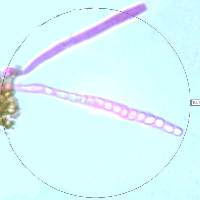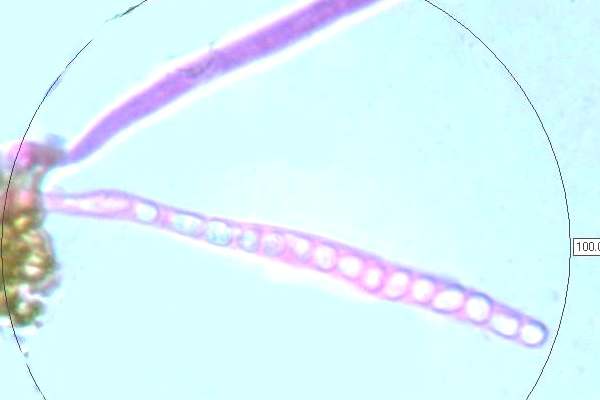Trichoderma viride Pers. / Hypocrea rufa (Pers.) Fr.
Phylum: Ascomycota - Class: Sordariomycetes - Order: Hypocreales - Family: Hypocreaceae
Distribution - Taxonomic History - Etymology - Identification - Culinary Notes - Reference Sources

In some field guides this species is referred to as Hypocrea rufa. That is because the anamorphic (asexual reproduction) stage of its lifecycle is associated with the name Trichoderma viride, while the teleomorphic (involving sexual reproduction via ascospores) is associated with the name Hypocrea viride.
This ascomycete mould fungus is the type species of the genus Hypocrea; however, it is not, as you might perhaps have expected, the type species of the genus Trichoderma. (That honour belongs to Trichoderma fuliginoides Pers.)
Recent research using DNA analysis techniques has shown that there is a complex group of closely-related species that are difficult to separate on macroscopic features. Trichoderma viride is distinguished by its globose, grossly-warted conidia (asexual spores), but to see such features with clarity scanning electron microscopy is required.
Uses
This fungus is of particular interest as a biofungicide, parasitiing the mycelia and fruitbodies of other fungi. It is used to treat soil and seeds in order to suppress a variety of diseases caused by fungal pathogens.
Distribution
Fairly common and widespread in Britain and Ireland, this wood-rotting fungus occurs also throughout mainland Europe, from Scandinavia right down to the southern shores of the Iberian Peninsula. This species is also recorded in many other parts of the world including Asia, Africa and North America.
Taxonomic history
In 1794 when Christiaan Hendrik Persoon described this species he named it Trichoderma viride. It is still generally referred to by this scientific name.
Synonyms of Trichoderma viride include Sphaeria rufa Pers., Hypocrea rufa (Pers.) Fr., Pyrenium lignorum Tode, and Trichoderma lignorum (Tode) Harz.
Etymology
The generic name Trichoderma means 'having a hairy skin' - a reference to the tiny hairs on the surface of young stromata. The specific epithet viride means 'green' and may be a reference to the green conidia or the mould that this fungus can produce in some plants, including onions.
Identification guide
 |
FruitbodiesThe complex orange-brown stromata are up to 10mm across and 3 to 5mm tall. The surface is finely hairy at first, and white blobs of spores eventually become visible at the reddish-brown openings of the ostioles. The circular perithecia are 100-150µm in diameter. |
 |
AsciCylindrical, slightly thickening towards tip; 80-100 x 4-5µm,uniserate with 16 part-spores per ascus. |
AscosporesPart-spores are hyaline, covered with minute warts (scanning electron microscopy required to see these features with any clarity), distal part-spores obovate, 4~4.5 x 3.5~4 µm, and proximal part-spores obovate-subcylindrical, 5~6 x 3~4 µm. Spore printWhite. ConidiaGlobose, green.
|
|
Odour/taste |
Not distinctive. |
Habitat & Ecological role |
Saprobic, on well-rotted wet wood. |
Season |
Particularly noticeable in summer, autumn and winter. |
Similar species |
There are many other very similar Trichoderma/Hypocrea species, but high-powered microscopy is necessary to identify them to species level with any certainty. |
Culinary Notes
This is not a species of culinary interest.
Reference Sources
Fascinated by Fungi, 2nd Edition, Pat O'Reilly 2016, reprinted by Coch-y-bonddu Books in 2022.
Dennis, R.W.G. (1981). British Ascomycetes; Lubrecht & Cramer; ISBN: 3768205525.
Breitenbach, J. & Kränzlin, F. (1984). Fungi of Switzerland. Volume 1: Ascomycetes. Verlag Mykologia: Luzern, Switzerland.
Medardi, G. (2006). Ascomiceti d'Italia. Centro Studi Micologici: Trento.
Dictionary of the Fungi; Paul M. Kirk, Paul F. Cannon, David W. Minter and J. A. Stalpers; CABI, 2008
BMS List of English Names for Fungi
Taxonomic history and synonym information on these pages is drawn from many sources but in particular from the British Mycological Society's GB Checklist of Fungi.
Fascinated by Fungi. Back by popular demand, Pat O'Reilly's best-selling 450-page hardback book is available now. The latest second edition was republished with a sparkling new cover design in September 2022 by Coch-y-Bonddu Books. Full details and copies are available from the publisher's online bookshop...


